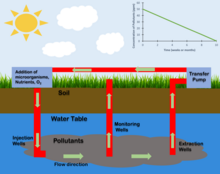In situ bioremediation
The Sun Oil pipeline spill in Ambler, Pennsylvania spurred the first commercial usage of in situ bioremediation in 1972 to remove hydrocarbons from contaminated sites.
[6] A patent was filed in 1974 by Richard Raymond, Reclamation of Hydrocarbon Contaminated Ground Waters, which provided the basis for the commercialization of in situ bioremediation.
[6] Accelerated in situ bioremediation is defined when a specified microorganism is targeted for growth through the application of either nutrients or an electron donor to the contaminated site.
Anaerobic in situ bioremediation often requires a variety of electron donors or acceptors such as benzoate and lactate.
[7] Accelerated in situ bioremediation is utilized when the desired population of microorganisms within a site is not naturally present at a sufficient level to effectively degrade the pollutants.
This process introduces nutrients and electron donors into the site allowing for the growth of a determined microbial population.
The presence of oxygen within a site is often the limiting factor when determining the time frame and efficacy of a proposed in situ bioremediation process.
[10] Despite being a strong oxidizing agent and potentially having a toxic effect on subsurface microbial populations, ozone can be an efficient means of spreading oxygen throughout a site due to its high solubility.
[11] Monitored natural attenuation is used in sites where the source of contamination is no longer present, often after other more active types of in situ bioremediation have been conducted.
[11] Naturally occurring within the soil are microbial populations that utilize hydrocarbons as a source of energy and carbon.
[9] These populations can through either accelerated or natural monitored attenuation be utilized to neutralize within the soil hydrocarbon pollutants.
[9] Hydrocarbon metabolism is an important facet of in situ bioremediation due to the severity of petroleum spills around the world.
[9] The fungus genus Phanerochaete under anaerobic conditions has species with the ability to metabolize some polynuclear aromatic carbons utilizing a peroxidase enzyme.

